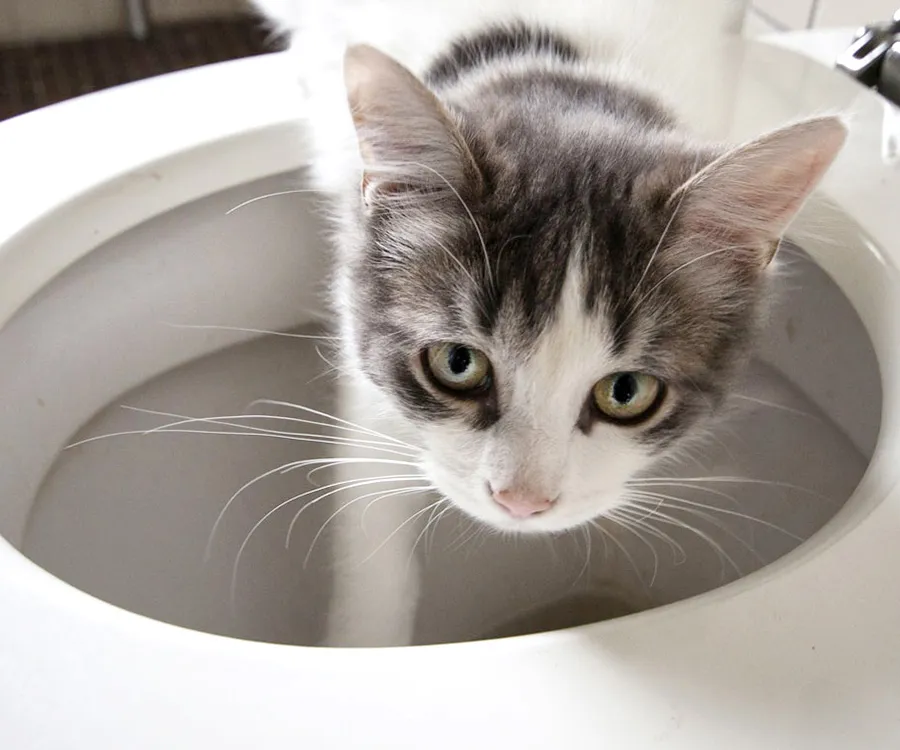Toilet training a cat might seem like a daunting task, but with patience and the right approach, it’s entirely achievable. Many cat owners dream of saying goodbye to litter boxes forever, and this guide on toilet training a cat will walk you through a proven 7-step method. Whether you’re dealing with a kitten or an adult feline, these steps ensure a smooth transition, minimizing accidents and building your cat’s confidence. We’ve drawn from veterinary insights and real-world experiences to make this process stress-free for both you and your pet.
Before diving in, remember that every cat learns at its own pace. Rushing can lead to setbacks, so observe your cat’s cues. If you’re new to cat training, check out resources like how to train your cat to high five for foundational tips that complement toilet training.
 Cat paw dipping into toilet bowl during training
Cat paw dipping into toilet bowl during training
Step 1: Position the Litter Box Near the Toilet
Start by relocating your cat’s litter box to a spot directly beside the toilet. This helps your cat associate the bathroom with elimination without overwhelming changes. Allow ample time—days or even weeks—for your cat to adjust comfortably. Monitor for consistent use to confirm they’re settled.
Expert Tip: Patience is key in toilet training a cat. Abrupt moves can confuse your pet, leading to accidents elsewhere in the home. According to the American Association of Feline Practitioners (AAFP), gradual environmental shifts reduce stress and support natural behaviors. If issues arise, revert to the original spot temporarily.
Step 2: Gradually Elevate the Litter Box
Once your cat is reliably using the new location, begin raising the litter box height incrementally. Use stable platforms like stacked phone books or newspapers, secured firmly to prevent slipping. Each elevation (about 1-2 inches at a time) should coincide with slightly reducing the litter depth.
This step mimics the toilet’s height, easing the physical transition. Cats are creatures of habit, so small changes prevent resistance.
Secure the setup so it doesn’t wobble under your cat’s weight—safety first!
 Cat sitting confidently on toilet during training process
Cat sitting confidently on toilet during training process
Step 3: Inch the Litter Box Closer to the Toilet
Over the next few days, move the litter box 1 inch closer to the toilet daily until it’s positioned right over the seat. Simultaneously, thin out the litter layer to no more than 1 inch deep. Your cat will start adapting to the proximity and reduced substrate.
Pro Tip: Clean the box meticulously after each use to maintain hygiene, a cornerstone of successful litter and toilet training. This prevents odor buildup, which can deter even the most adaptable cats.
For more behavior insights, explore how to get a cat to behave, which covers reinforcement techniques useful here.
Step 4: Switch to a Training Device
Replace the standard litter box with a specialized training apparatus that fits over the toilet seat. Options include commercial kits or DIY versions. For a homemade one:
- Raise the toilet seat and tape wax paper over it entirely.
- Sprinkle flushable, biodegradable litter on top.
- Alternatively, secure a shallow aluminum pan or bowl to the seat edges with tape, then add litter.
Enhancement: Add a pinch of catnip to the fresh litter post-cleaning—it encourages enthusiastic use. Veterinary experts recommend flushable litters free of clumping agents to avoid plumbing issues.
This phase bridges litter habits to true toilet use, typically taking 1-2 weeks.
Step 5: Introduce the Toilet Hole Gradually
Now, cut a small 1-inch hole in the center of the wax paper or pan. Enlarge it progressively over days until the covering is minimal or gone, while eliminating litter entirely. Your cat will learn to aim directly into the bowl.
Monitor closely; praise successes verbally to reinforce positive associations. If hesitation occurs, pause progression—cats thrive on confidence.
Building on basic skills? Pair this with how to train your kitten tricks for fun, engaging sessions.
Step 6: Teach Proper Flushing Post-Use
After your cat eliminates, flush the toilet yourself each time. Demonstrate calmly without startling them. Importantly, avoid training them to flush independently—cats may overdo it, leading to water waste.
Safety Note: From ASPCA guidelines, ensure no hazards like open lids during unsupervised times. This step solidifies the routine.
Step 7: Reward and Reinforce Success
Celebrate milestones with high-value treats immediately after successful uses. Positive reinforcement, backed by behaviorist studies from the Journal of Feline Medicine and Surgery, cements habits long-term.
If water in the bowl intimidates, mix in a bit of litter scent initially for familiarity.
For sitting commands that aid training, see how to train my cat to sit.
Final Thoughts on Toilet Training Your Cat
Mastering toilet training a cat in these 7 steps transforms a messy chore into a clean, convenient reality. Key takeaways: go slow, prioritize safety, and use rewards generously. Consult your vet if behavioral issues persist, as they could signal health concerns like urinary problems.
Embrace the journey—your cat will thank you with a stronger bond. Ready for more? Dive into our cat care guides for ongoing tips!
References:
- American Association of Feline Practitioners (AAFP) Litter Box Guidelines
- ASPCA Cat Behavior Resources
- Journal of Feline Medicine and Surgery on Positive Reinforcement
